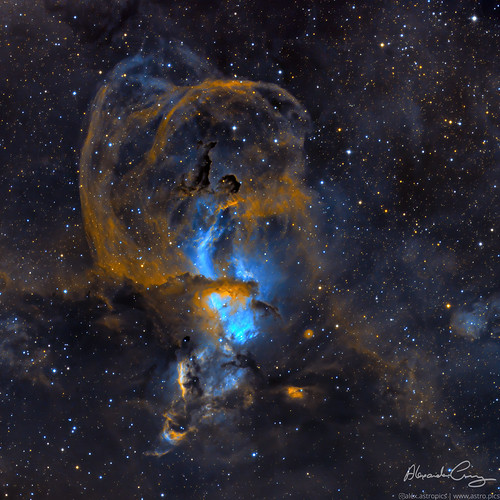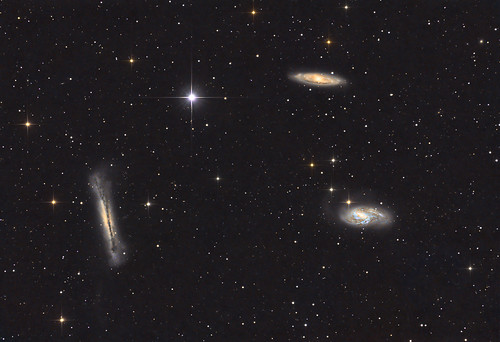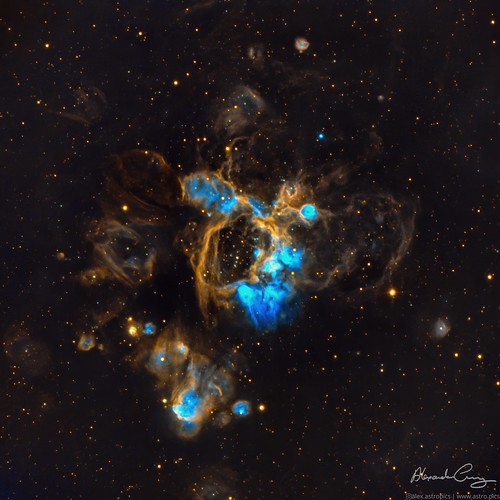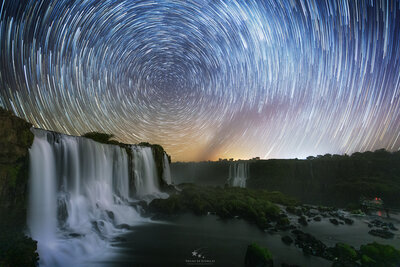Page 1 of 4
Submissions: 2021 May
Posted: Mon May 03, 2021 12:54 pm
by bystander
__________________________________________________________________________________________________
Please post your images here.
Please see
this thread before posting images; posting images demonstrates your agreement with
the possible uses for your image.
If hotlinking to an image, please ensure it is under 500K.
Hotlinks to images over 500K slow down the thread too much and will be disabled.
Thank you!
_________________________________________________________________________________________________
<- Previous submissions
Re: Submissions: 2021 May
Posted: Mon May 03, 2021 12:59 pm
by AlexanderCurry
The Statue of Liberty Nebula
Captured using a Telescope Live remote telescope
Acquisition details:
Planewave CDK 24
Mathis MI 1250
FLI PL 16803
4 x 300s Ha, G, OIII
Processed with Pixinsight and TopazLabs DenoiseAI

Re: Submissions: 2021 May
Posted: Mon May 03, 2021 4:55 pm
by Yovin Yahathugoda
NGC 5189 - Planetary Nebula
https://www.astrobin.com/users/YovinRY/
Copyright: Yovin Yahathugoda
Full quality version here:
https://cdn.astrobin.com/images/86236/2 ... 06c72c.png
The image has been processed in the SHO palette and upscaled using Topaz Gigapixel AI.
Telescope - Planewave CDK24
Camera: FLI ProLine PL9000
Filters: Astrodon Ha 3nm, Astrodon OIII 3nm, Astrodon SII 3nm
Software: Photoshop 2020, PixInsight, Topaz Denoise AI & Topaz Gigapixel AI
Location - El Sauce Observatory, Chile
Dates - March 2021 - April 2021
Lum - Synthetic Luminance
Halpha - 4x600s
OIII - 4x600s
SII - 4x600s
Total Exposure time - 2.0 hours
Full acquisition details at
https://www.astrobin.com/h0h7v0/0/
Re: Submissions: 2021 May
Posted: Mon May 03, 2021 6:04 pm
by mdieterich
Zodiacal Light from New Mexico
www.mattdieterich.com
Copyright: Matt Dieterich
Last night after arriving to Dark Sky New Mexico Observatory, the Zodiacal Light was incredibly bright over the mountains! Zodiacal Light is an angled column of light that appears to emanate above the horrible shortly after sunset, or before sunrise. The phenomenon is caused by sunlight reflecting off dust particles in our Solar System.
Re: Submissions: 2021 May
Posted: Mon May 03, 2021 10:11 pm
by markg
Two Worlds
https://theartofnight.com
Copyright Mark Gee
 Two Worlds
Two Worlds by
Mark Gee, on Flickr
Shot with a Nikon D850 and a 14mm lens in a Aquatech underwater housing.
The image is focus stacked and there are 7 steps of focus within the image. At each focus step I shot 15 exposures for stacking to give me a better image quality with less noise. The image was initially processed in Adobe Lightroom, the image stacking for each focus step was done in Starry Landscape Stacker before processing the focus stack in Focus Stacker.
Each exposure was shot with a 30 second shutter, f/4.0 Aperture and an ISO of 6400.
Re: Submissions: 2021 May
Posted: Tue May 04, 2021 6:39 am
by TaraMostofi
Mercury and the Pleiades (Seven Sisters) taken from Northern California 3 May 2021 at 9:04 pm just after sunset
Thank you for your consideration.
Tara Mostofi
Re: Submissions: 2021 May
Posted: Tue May 04, 2021 8:43 am
by Llama
Wide view of Rho Ophiuchi - 3 Panel Mosaic
Copyrights:
Nicolas Rolland &
Martin Pugh
Full resolution:
https://www.astrobin.com/full/9ifl5y/0/
 Wide view of Rho Ophiuchi - 3 Panel Mosaic
Wide view of Rho Ophiuchi - 3 Panel Mosaic by
Nicolas Rolland, sur Flickr
This picture is a 3 panel mosaic.
Original file size of the JPEG version: 21998x13317 pixels (140mo file size)
RA: 16h 24m 19.7s
DEC: -23° 26’ 55.6“
Location: Ophiuchus
Distance: 390 ly
Magnitude: 5.09
Captured April 2021
Fiel Of view: 22.4 x 13.6 deg
Total integration time of 12 hours.
RGB: 24x600sec per panel
Optics: Sigma 135mm f/1.8 DG HSM Art
Mount: Paramount ME II
CCD: QHY600 C
Re: Submissions: 2021 May
Posted: Tue May 04, 2021 9:56 am
by Jean-Baptiste Auroux
NGC 3521 - a bubble galaxy
Real full version :
https://cdn.astrobin.com/thumbs/iVLJeSY ... muqi8S.jpg
My version of the NGC 3521 Galaxy.
Acquisitions by Greg Turgeon (@gregturgeon_astro), who has graciously provided it as the second part of a contest !

This floculent spiral galaxy lies in the constellation of Leo, and is distant about 35 millions LY.
Setup :
Telescope: Planewave 17” CDK - Camera: FLI ML16803 - Filters: Chroma LRGB 8nm - Mount: 10 Micron GM3000 - Location: DSW, Chile
150 x 300s (12,5h)
Copyright: Jean-Baptiste Auroux / Greg Turgeon
https://millenniumphoton.com/
Re: Submissions: 2021 May
Posted: Wed May 05, 2021 11:01 am
by jamesastro1234
 Leo Triplet LRGB 15hr
Leo Triplet LRGB 15hr by
James, on Flickr
15hr on the Leo Triplet.
4hr RGB
11hr Lum
Skywatcher 200PDS
ASI294mm
Captured in Central Scotland, processed in Pixinsight.
Re: Submissions: 2021 May
Posted: Wed May 05, 2021 11:29 am
by AlexanderCurry

@alex.astropics on Instagram
N44 Superbubble Complex
Captured using a TelescopeLive remote telescope
Acquisition details:
PlaneWave Instruments INC CDK 24
Mathis MI-1250
FLI PL 16803
Astrodon 3nm filters
25 x 300s Ha, OIII, SII
Processed with Pixinsight and Topaz Labs DenoiseAI
Re: Submissions: 2021 May
Posted: Wed May 05, 2021 11:13 pm
by Sebastian Voltmer
Currently Venus begins an evening apparition that is difficult to observe.
Here is a compilation, starting with the evening apparition of Venus from last year until now (almost full illuminated).
About this image compilation:
Phases of Venus captured during daytime.
April 23, 2021: almost full (99.1)
July 2, 2020: Venus ring (<0.20)
without dates
Filters: Baader U, IR pass, RGB
Amplification: Baader FFC
Gear:
- Astro-Physics Traveler
- C11 EdgeHD
- Baader FFC
- U, IR-pass, RGB filters
- ASI290MM
Credit:
Dr. Sebastian Voltmer
www.voltmer.photo
Clear Skies,
Sebastian
Re: Submissions: 2021 May
Posted: Thu May 06, 2021 6:38 am
by YSTY

IC 1318 in SHOalittleRVB
90x300 '' IDAS NBZ for the Ha Oiii
35x600 '' IDAS NBZ for the Ha Oiii
140x90 '' IDAS P3 for RGB
Synthetic Sii in Pixinsight
Asi 2600mc pro gain 100 offset 50 cooled to -10 ° C
TS Photon 8 '' 200/800
Eq6R pro
Altaïr 60/225 and zwo 290mm mini guide
Acquisition: Nina / PHD 2
Processing: Siril / PixInsight / PS
Yann SAINTY - France - 04/27/21
Re: Submissions: 2021 May
Posted: Fri May 07, 2021 11:43 am
by Kinch
Messier 3 - Globular Star Cluster
This cluster is one of the largest and brightest, and is made up of around 500,000 stars. It is estimated to be 11.4 billion years old. It is centered at 32,615.64 light-years (10 kpc) away from Earth.
Click on above to enlarge.
Full info @
https://www.kinchastro.com/messier-3-2021.html
Re: Submissions: 2021 May
Posted: Fri May 07, 2021 10:41 pm
by barretosmed
THE SUN
Equipment :
Lunt60mm
Qhy 174mm coled
More details:
https://www.astrobin.com/full/u2ihd3/0/?nc&real&mod
Local: Sao Paulo-SP-Brazil
Date: 05/06/2020
Copyright: Fernando Oliveira de Menezes
Re: Submissions: 2021 May
Posted: Sat May 08, 2021 11:06 pm
by barretosmed
The Sun in H Alpha
More details:
https://www.astrobin.com/full/xvud6s/0/?nc&real&mod
Equipment
LUNT LS60MT / B1200C
QHY 174MM coled
POWERMATE 2.5X
Location: Sao Paulo - SP - Brazil
Date: 05/05/2021
Copyright: Fernando Oliveira de Menezes
Re: Submissions: 2021 May
Posted: Sat May 08, 2021 11:09 pm
by Alson Wong
The Eyes Galaxies
Copyright: Alson Wong
Re: Submissions: 2021 May
Posted: Sun May 09, 2021 3:29 am
by Guest
The Different Faces of the Pleiades
The Pleiades, fondly known as the Seven Sisters, is a star cluster visible naked eye even from moderately light-polluted skies. The Pleiades along with the Hyades in Taurus form the Golden Gate of the Ecliptic. The ecliptic is the sun’s apparent path through the sky, and the planets and moon are always close to this virtual line. As such, the celestial bodies are frequently “passing through” the Golden Gate. I made this composite picture of the 4 occasions I had a chance to photograph the Pleiades in the past 13 months to demonstrate the different photographic techniques necessary to present it with its planetary visitors. Venus was tricky as it was 200 times brighter than the Pleiades. On 2 April 2020, I took a 1-minute exposure with a string on the front of my refractor telescope to create star spikes and make for a more interesting picture. 15 Nov 2020, I had a chance to photograph the Pleiades alone, taking exposures over several hours and digitally stacking them to bring out the details in the beautiful reflection nebula. 3 May 2021, I used a similar stacking technique while Mars was passing by, but the Pleiades was in a less ideal part of the sky and the light pollution from my back yard interfered with getting enough data to really show off the reflection nebula. On 3 May 2021, I had a chance to barely catch the Pleiades with the more elusive planet Mercury, the closest planet to the sun. I caught the pair during twilight just after sunset with a 4-second snapshot, it was a truly breathtaking sight.
Re: Submissions: 2021 May
Posted: Sun May 09, 2021 2:41 pm
by Nicolas Adriano
Southern Jewels
https://cdn.astrobin.com/images/67318/2 ... c8f729.png
Copyright: Nicolas Adriano
This image is a 3-panel HaRGB mosaic of the Eta Carinae region in the southern part of the Milky Way. It's possible to see all the emission nebulae together with the various star clusters of the region in constrast with a sea of stars and dark nebulae on the background.
Dates: 21, 22, 23, 31 March 2021 - 01, 02, 03, 04, 05 April 2021
Location: Backyard, MG, Brazil. Suburban Skies (Bortle 5, SQM ~19.87)
Camera: Nikon D5300 (modded) @ ISO200
Optics: Rokinon 135mm F/2.0 ED UMC
Mount: Sky-Watcher Star Adventurer
Exposure Detail: 3-panel mosaic | 141x60s, 171x60s and 65x120s for Color | 55, 74 and 63x120s for Ha | Total integration time 826’ or 13,76hrs, unguided.
Re: Submissions: 2021 May
Posted: Mon May 10, 2021 3:26 am
by Sergio
NGC 3293 & NGC 3324
NGC 3293 is an open cluster 2 degrees to the north from the Keyhole Nebula in the constellation of Carina. It was discovered by French Astronomer Nicolas Louis Lacaille in 1751. The cluster consists of more than 100 stars brighter than 14th magnitude in a 10 arc minute field, the brightest of which are blue supergiants of apparent magnitude 6.5 and 6.7. There is also a 7th magnitude pulsating red supergiant V361 Carinae which is visible in the image. NGC 3293 is also known as the "Gem Cluster" because the appearance of its attractive components.
NGC 3324 is an open cluster associated with nebulosity located northwest of the Carina Nebula at a distance of 7,560 light years from Earth. It is closely associated with the emission nebula IC 2599, also known as Gum 31. The two are often confused as a single object, and together have been nicknamed the "Gabriela Mistral Nebula" due to its resemblance to the Chilean poet. NGC 3324 was first catalogued by Scottish James Dunlop in 1826.
More info and higher resolution image at
www.baskies.com.ar
Cheers to all !!!
Sergio
Re: Submissions: 2021 May
Posted: Mon May 10, 2021 5:13 pm
by Lefty's Astrophotography
This is my demonstration of how pixel rejection/image stacking can mitigate the effects of satellite trails.
Each exposure is 120" from my Bortle 6 driveway. Captured using a 6" f/4 newtonian, ASI1600, and Astronomik filters on an Orion Sirius mount.
I also included a longer writeup on it in the image description:
https://www.flickr.com/photos/leftysast ... 1169334733
Direct link to the full res image:
https://live.staticflickr.com/65535/511 ... 4508_o.png
Re: Submissions: 2021 May
Posted: Mon May 10, 2021 6:11 pm
by SpookyAstro
 Comet C/2020 R4 (ATLAS) Passes by the Hockey Stick and Whale Galaxies
Comet C/2020 R4 (ATLAS) Passes by the Hockey Stick and Whale Galaxies by
Transient Astronomer, on Flickr
Image Credit and Copyright Grand Mesa Observatory, Terry Hancock, Tom Masterson
Re: Submissions: 2021 May
Posted: Mon May 10, 2021 6:57 pm
by jose
http://halfa.webcindario.com/IC-1396HOS ... nombre.jpg
La nebulosa de la Trompa del Elefante es una concentración de gas, polvo y gas ionizado interestelar situada en la constelación de Cefeo unos 2.400 años luz de distancia de la Tierra. La fracción de la nebulosa que se muestra aquí es la oscura y densa IC1396A; lo que comúnmente se llama la nebulosa Trompa de Elefante, debido a su apariencia en longitudes de onda visibles, donde se observa una mancha oscura con un borde brillante y sinuoso. El borde brillante es la superficie de la densa nube que se está iluminado y ionizada por una muy brillante estrella masiva que está justo al oeste de IC1396A. Toda la región IC1396 está ionizado por esa estrella masiva, con excepción de los glóbulos densos que quedan protegidos de los rayos ultravioleta de la estrella.
La nebulosa Trompa de Elefante se piensa ahora que es un lugar de formación de estrellas, que contiene varias estrellas muy jóvenes (menos de 100.000 años) que fueron descubiertas en imágenes infrarrojas en el año 2003. Dos estrellas más viejas se encuentran en una pequeña cavidad circular en la cabeza del glóbulo. Los vientos solares de estas estrellas jóvenes pueden haber vaciado de la cavidad.
La acción combinada de la luz de la estrella masiva ioniza y comprime el borde de la nube, y el viento de las estrellas jóvenes expulsando el gas de zona central hacia el exterior, se traduce en una elevada compresión sobre la nebulosa. Esta presión ha disparado la actual generación de protoestrellas.
TOMAS:
H alfa: 20 Light de 900 segundos; 30 flats, 20 darks y 50 bias
OIII: 17 Light de 900 segundos; 30 flats, 17 darks y 50 bias
SII: 15 Light de 900 segundos; 30 flats, 15 darks y 50bias
PALETA:
HUBBLE
R= SII
G= H-alfa
B= OIII
L= H-alfa
TEMPERATURA: -10 GRADOS
TUBO: FSQ 106 ED
CCD: SBIG ST-8300M
MONTURA: CGEM
CCD guiar: QHY5II
LUGAR: TORREJÓN DE ARDOZ y LAS INVIERNAS (GUADALAJARA)
Re: Submissions: 2021 May
Posted: Tue May 11, 2021 12:17 pm
by Aleix_Roig
Leo Triplet with NGC 3628's tidal tail
https://www.astrobin.com/p4utth/E/?nc=user

The Leo Triplet, also called the M66 Group, is a small group of spiral galaxies located in the Leo constellation at approximately 35 million light-years. It's composed of three major spiral galaxies: M65, M66 and NGC 3628 (Hamburger Galaxy). NGC 3628 has a 300,000 light-year long tidal tail. This amazing stream of stars has been drawn out of the galaxy by gravitational tides during past interactions with neighbouring galaxies.
This image has been possible thanks to the Prades (Tarragona) dark sky. The NGC 3628's tidal tail is a faint structure that needs quite deep integration times to show up some detail.
Image details:
Luminance: 250x120"
RGB: 40x120" (each filter)
All images at 120 Gain -15ºC bin2
Calibrated with 50 flats, 50 darks and 50 bias
Total exposure: 12h20'
Image resolution: 2.12"/pixel
Average darkness: 21 mag/arcsec2
Equipment:
FSQ85ED telescope
Mesu200 mount
ASI294MM Pro camera with ZWO EFW 8 pos
Guiding with ASI174MC and ZWO OAG
Baader filters
Software:
SGP, PHD2, APP, PIX.
Aleix Roig - Prades, Catalonia, Spain. May 2021.
Re: Submissions: 2021 May
Posted: Tue May 11, 2021 3:13 pm
by Eliholla1
Dark Dust and Glowing Hydrogen in Cygnus.
Imaged with an Unmodded dslr. 1 hour of exposure time.
2min subs
ISO 1600
f5
Taken on: May 10th, 2021
Equipment details-
Canon EOS 2000d (Stock)
Sigma 150-600c
Celestron AVX
Guider-
ZWO ASI 120-MC-S
ZWO 30mm miniscope
Re: Submissions: 2021 May
Posted: Tue May 11, 2021 8:57 pm
by Victor Lima
CATEGORY: STACKED
SOCIAL IG: @victorlimaphoto
STORY:
Star Trail over Salto Santa Maria, one of the main waterfalls of the Iguaçu Falls complex in Brazil.
Photographing Iguazu Falls at night has always been one of my priority projects. For that, it was necessary to obtain a special authorization from the environmental agency responsible for national parks in Brazil. Finally, in early 2021, I got this authorization and set out to put my plan into practice.
I spent 4 days inside the Iguaçu National Park with exclusive access at night to the Falls for me and my students. The first challenge is to walk around the park at night knowing that several jaguars reside there, which are frequently seen by employees and tourists. In the area closest to the main waterfalls, the big challenge is to make long exposure images with the strong water spray from the more than 1.5 million liters per second that fall through the waterfalls. Working with exposure times longer than 30 seconds became an almost impossible task and the lens was never dry.
To assemble the Star Trail, the Sequator software was used.
EXIF:
Canon R5 / Canon EF 16-35mm f/2.8L II USM
86x 16mm | f/2.8 | 30 sec | ISO 4000 (Sequator)

- Star Trail at Iguassu Falls - Victor Lima - Brazil













